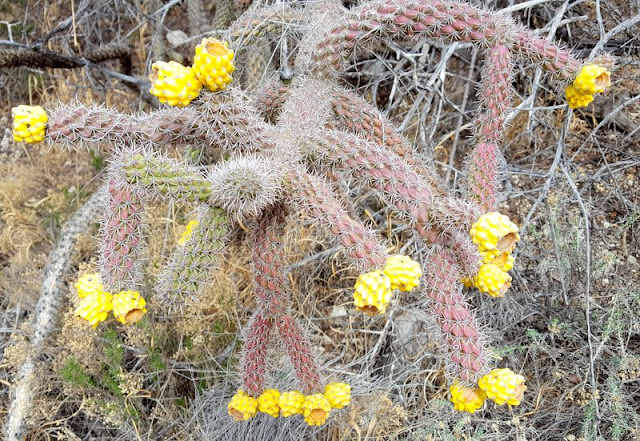We would love to buy nuts from the locals that are growing them, but that isn't a possibility here. Everyone tell us that the orchards are now owned by corporations that ship the harvest to processing plants far away from Bowie. They are shipped in bags the size of a small automobile. That's a lot of nuts!
Our drive to the national park from Bowie was only 13 miles, but half of it was on winding dirt roads.
Along this dirt road we saw the highest concentration of century plants that we have ever seen. There are four of these once-in-a-lifetime blooms in the picture below, but there were a hundred others around them.
Besides being located along a dirt road, this national historic site is also unique in that there is a 1.5 mile hike from the parking lot to get to the visitor center. It takes dedicated tourists to make this hike through the mountains!
To keep us entertained on the hike, there were some plants starting to bloom along the trail.
Spring is just around the corner, as this bush is setting on tiny heart-shaped blooms.
There were plenty of the usual Engelmann cacti, but this pink cactus was prettier. It must have looked good enough to eat, as it had recently been nibbled.
Also along the trail was a reproduction of a Native American thatched wickiup. Made of the native grasses, they could be hidden in this environment for added safety. The Apaches lived here many years ago, and didn't take kindly when the white settlers made their way west.
Both groups made their way here because of the pass between two mountain ranges, and the precious water source of Apache Springs. Today it was a peaceful place, but in the 1860's, this was the location of much turmoil.
Our next stop was the cemetery, where many headstones told the story of this conflict. Most of them had the statement, "Killed by Apaches." This is the final resting place of John Brownley, who was the 25-year-old assistant driver on one of the Butterfield stages that delivered mail across the United States. The two drivers and their two army escorts were killed by the Apaches on May 26, 1868, as they made their way through this pass.
Just as sad was the death of Geronimo's son, who died of dysentery when he was only two. He was part of the group of Apaches held at Fort Bowie, and he died ten days after their arrival. The soldiers had the young boy buried at the Fort's cemetery.
We've walked for over a mile now, and we still haven't seen Fort Bowie. Built in 1862, it was the center of the military campaigns to protect white settlers against hostile Apaches. The remains of the fort are situated in a high valley surrounded by peaks.
There are only foundations and partial walls left of the fort that once housed 300 soldiers. Denisa is standing in the middle of the remains of one of their barracks.
Mark is standing beside the foundation of the commanding officer's house.
The officer complained that a fancy Victorian house was impractical to heat and cool, and certainly didn't fit in with the desert surroundings. Based on the picture, we would have to agree.
We walked around the entire fort, including its original location to the west. It was good exercise, but there are only foundations and partial walls to see. When the Apaches were relocated to other reservations, there was little reason to keep this fort in operation. So in 1894, the cavalry rode away and the buildings were left to decay in the desert.
As we circled to the end of the grounds, we heard movement in the brush near us. We spotted three collared peccaries. The one at the bottom of the picture had just started munching on the roots of an agave plant.
He paused to look at us before he continued digging up the root with his hooves and snout.
It must have been very tasty, as it looks like he was smiling in the next picture.
We watched as he completely destroyed the agave plant and ate only the roots. He left the green leaves with their barbed edges in a pile, but didn't even try to eat them.
Only minutes before, that plant had looked like this healthy agave plant. We could only imagine the kind of damage these javelinas can do to a flower bed or garden or field of crops.
Another name for that agave is a "century plant." That is because they must be very old before they bloom for the first (and only) time. They produce a once-in-a-lifetime stem with bright yellow flowers. The bloom can be very tall. Based on Denisa's 5' 2 and 3/4" height, we would estimate this one to be around 18' 3 and 5/8" tall. But that's just a rough estimate.
The one above was last year's bloom, as all the blooms have dried and formed seeds that were dispersed. That tall stem will eventually fall to the ground, and the mother plant that produced it will die. This blog seems to be filled with dark symbolism about motherhood today!
We are definitely back in the desert, surrounded by the cacti and desert plants. We didn't know much about desert plants when we first visited Arizona two years ago. Now many of these plants are familiar to us. In the picture below we captured from left to right: ocotillo, agave (past bloom and young plant) and the Engelmann prickly pear. It was a veritable cacti smorgasbord!
It seems somehow fitting to end our last day in our campground near Bowie with another beautiful sunset silhouetted by a blooming yucca plant. We've enjoyed the sites, we've enjoyed the desert, and mostly we've enjoyed the people at this stop in our journey!


























No comments:
Post a Comment